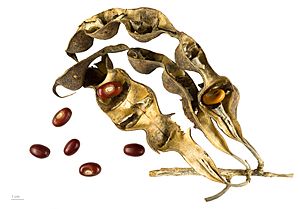Chilicote facts for kids
Quick facts for kids Erythrina flabelliformis |
|
|---|---|
 |
|
| Scientific classification | |
| Kingdom: | |
| (unranked): | |
| (unranked): | |
| (unranked): | |
| Order: | |
| Family: | |
| Genus: |
Erythrina
|
| Species: |
E. flabelliformis
|
| Binomial name | |
| Erythrina flabelliformis Kearney
|
|
| Synonyms | |
|
Erythrina purpusii Brandegee |
|
The Western Coral Bean (scientific name: Erythrina flabelliformis) is a cool plant often called chilicote. It's a type of shrub or small tree. You can find it growing naturally in parts of Mexico and the southwestern United States.
Contents
Where the Western Coral Bean Grows
This plant is native to a wide area. It grows in central and northwestern Mexico. You can find it in places like Baja California and Morelos. It also grows as far east as San Luis Potosí. In the United States, it is found in Arizona and New Mexico.
What the Western Coral Bean Looks Like
The Western Coral Bean is usually a shrub. Sometimes, it can grow into a small tree. It can reach about 3 meters (10 feet) tall.
Stems and Prickles
When the stems are young, they are white. They feel soft and velvety. These stems also have curved, sharp prickles. These prickles are about 6 millimeters (0.25 inches) long.
Leaves and Flowers
The leaves of the Western Coral Bean are interesting. Each leaf has three parts, called leaflets. These leaflets are stiff and feel leathery. They are usually wider than they are long.
The plant produces bright, scarlet-red flowers. These flowers grow close together. They are found at the ends of the branches. Each flower is about 4 centimeters (1.6 inches) long.
Fruit and Seeds
After the flowers, the plant grows fruit. The fruit is long and gets narrower at both ends. It is covered with tiny, dense hairs.
Inside the fruit are the seeds. The seeds are oval-shaped. They can be up to 15 millimeters (0.6 inches) across. They are a bright scarlet color. Each seed has a small white mark called a hilum.
Important Safety Note
The seeds of the Western Coral Bean are very important for the plant. However, they contain special chemicals called alkaloids. These chemicals make the seeds poisonous if eaten. It is very important to remember that these seeds are not safe to eat. Always be careful around plants and never eat parts of a plant unless an adult tells you it's safe.
Images for kids
See also
 In Spanish: Cucurbita foetidissima para niños
In Spanish: Cucurbita foetidissima para niños


